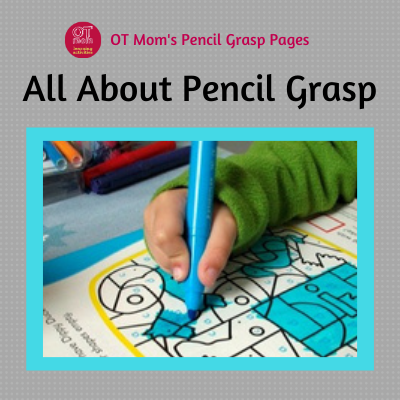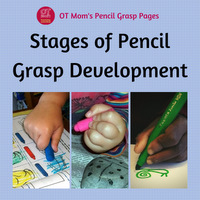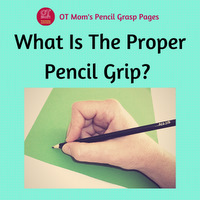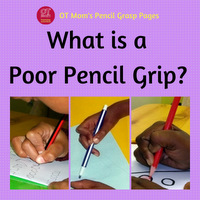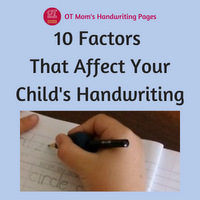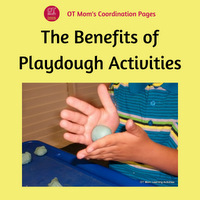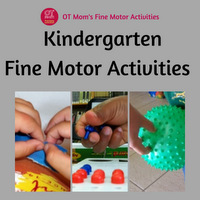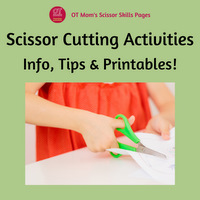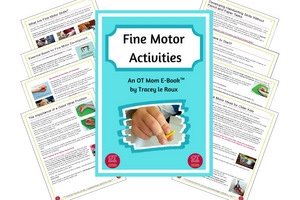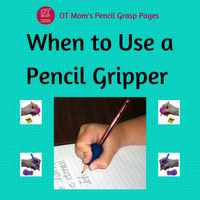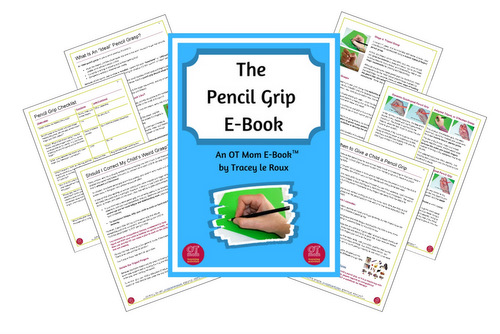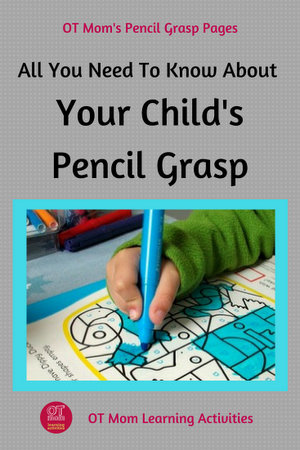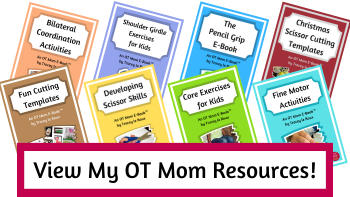- Home Page
- All About Pencil Grasp
Pencil Grasp - An Overview
Teachers often refer kids for OT assessments out of concern over their pencil grasp.
Holding the pencil with a functional grasp allows the child to write neatly at a reasonable speed without tiring easily. Poor pencil grasps not only look awkward but they do not use the hand muscles efficiently. This may result in the child tiring easily and being unable to produce neat handwriting
This page contains a brief overview of the different questions parents often ask, with links to more in-depth pages on my site.
How Pencil Grasp Develops
As your child's body matures and strengthens, so the way your child grasps a crayon will develop and mature.
You would not expect your toddler to walk and run and skip like a 6 year old, so why expect your toddler to hold a pencil like a 6-year old? Their little bodies need to mature in all kinds of ways in order to develop a mature pencil grasp at the right time.
Usually, given normal play and development opportunities (lots of preparatory skills like cutting etc), by the time your child is 5-6 years old, he/she will have the correct pencil grip needed for handwriting.
But if we force the "correct grip" before the muscles are developmentally ready to control the pencil in that way, we run the risk of awkward pencil grasps emerging.
It is really important that you understand how a pencil grip develops and do not force your toddler to use a grasp that he/she is not yet ready for.
So read my page about the developmental stages of pencil grasp development.
What Is The Proper Pencil Grip?
Studies have shown that being able to use the small muscles of the hand and fingers plays a big role in a child’s handwriting, so it makes sense that a proper pencil grip should allow those refined finger movements.
An immature or poor pencil grip tends to block the finger movements, which results in the child moving from the wrist or from the arm in order to write.
Teachers have traditionally considered the correct pencil grasp to be the “dynamic tripod” grasp, where the thumb, index and middle fingers are holding the pencil.
However, there are some variations on the dynamic tripod grip that researchers have found to be almost equally efficient during limited clinical trials.
Visit my page to view the different functional, "proper" pencil grasps that kids can use.
What Is A Poor Pencil Grip?
If your child’s pencil grip blocks finger movements, it may cause unnecessary fatigue, discomfort and messy work.
This in turn may affect handwriting, because the child will be using the wrist and arm muscles to move the pencil and form the letters.
A poor pencil grip may be the red flag that a teacher uses to send a
child for an occupational therapy evaluation, but a good OT will assess
all the different factors that are possibly influencing your child’s
handwriting. The pencil grip alone is not usually the cause of the poor handwriting.
A poor pencil grip is often compensating for other skills that are missing or weak, and an OT will be able to see what skills need to be worked on.
Check out my page of Poor Pencil Grips for more information and pics to help you see what grips are not functional.
A poor pencil grip together with messy handwriting can also be a symptom of dyslexia. This link goes to an article on the Dyslexia website.
Back to Top
Pencil Grasp And Handwriting
Studies have shown that dexterity of hand and finger muscles has a big influence on handwriting ability (along with good visual-motor integration skills).
When a child’s handwriting is poor, the pencil grip may be the first thing that the teacher notices.
However, there are many different factors affecting handwriting, and a poor pencil grip may be just one of the factors affecting your child's handwriting.
The pencil grip is therefore important as far as it allows the child to use the fingers freely or not.
When the fingers can move freely with the correct amount of control, the pencil can be turned and manipulated to form the different letters accurately.
If your child has a reasonably efficient pencil grasp, but still struggles with handwriting, perhaps take a look at improving visual-motor integration skills to help with flow and legibility of letter formations.
If you are concerned about your child's handwriting, I highly recommend getting an occupational therapy assessment to help identify the underlying causes of handwriting issues.
How Can I Help My Child?
Contrary to popular opinion, pencil-and-paper activities are NOT the best way to help your child develop a good pencil grasp!
Learning to hold and use a pencil or crayon does not develop in isolation from other fine motor skills. There are a number of underlying foundations that can help your child develop good fine motor skills.
If you make sure that your child is developing important foundation skills, then you are helping your child have a good chance at developing a functional, efficient pencil grasp.
Even if your toddler naturally gravitates to coloring and scribbling with a crayon, encourage all-round fine motor development with the range of activities on the pages below:
Should I Correct My Child's Weird Grasp?
A functional pencil grip will allow hand and finger muscles to move freely (although some grips are better at this than others), which can help your child's handwriting skills.
If your child has a poor pencil grip that affects handwriting and work completion, then just telling your child to “hold the pencil better” is NOT going to help!
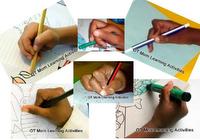 Some dysfunctional pencil grips
Some dysfunctional pencil gripsTo counteract fatigue, help your child to work on hand and finger strength and dexterity.
If you have been working on hand and finger strength, you can then try out a variety of pencils and pencil grippers to try and increase your child's comfort while writing.
I recommend an occupational therapy assessment to help figure out WHY your child is holding the pencil so badly, and then you and the OT can make a plan to work on the skills that are missing.
If your child has a weird pencil grip, but currently seems to be keeping up with classwork, and has neat handwriting, then my recommendation is that you keep a careful eye out for hand fatigue and deteriorating work (especially as the writing load increases).
All This Pencil Grip Info and Much More!
This printable resource aims to help by answering common questions that teachers and parents have about how a child should hold a pencil.
This e-book explores various functional pencil grasps, dysfunctional pencil grips, and the various developmental stages of holding a pencil.
Lots of photos, as well as a pencil grasp checklist!
Thanks for visiting! I hope you were helped! If you were, then please share this page to help others!
Why not sign up for my newsletter to keep in touch with new pages and activities on my site?
- Home Page
- All About Pencil Grasp
Share this page to help others!
References And Resources
1. Koziatek, S. ; Powell, N.J. Pencil Grips, Legibility, and Speed of Fourth-Graders' Writing in Cursive AJOT 57(3):284-8 May 2003
DOI: 10.5014/ajot.57.3.284
2. Schwellnus, H.; Carnahan, H. ; Kushki, A. ; Chau, T. Writing Forces Associated With Four Pencil Grasp Patterns in Grade 4 Children AJOT March 2013
DOI: 10.5014/ajot.2013.005538
3. Selin, A-S. Pencil Grip: A Descriptive Model And 4 Empirical Studies (dissertation). Abo Akademi University Press, 2003.
ISBN 951-765-130-9 ISBN 951-765-130-9
4. Ziviani, J. ; Elkins, J. Effect of Pencil Grip on Handwriting Speed and Legibility. Educational Review 38(3):247-257 • November 1986
DOI: 10.1080/0013191860380305
Didn't find what you were looking for? Try a search of my site!
